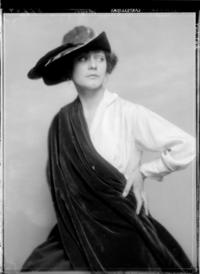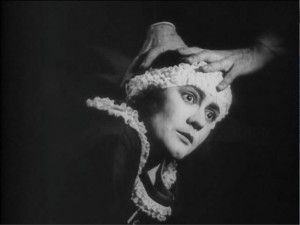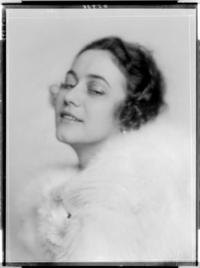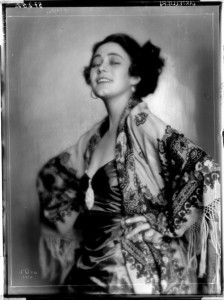by
Robert von Dassanowsky
Carmen Cartellieri was born Franziska Ottilia Cartellieri in Prossnitz, Austria-Hungary, which is today Prostejov, Czech Republic, but spent her childhood in Innsbruck, Austria. In 1907, at age sixteen, she married the aristocratic artist-turned-director, Emanuel Ziffer Edler von Teschenbruck. Her husband and Cornelius Hintner, a cameraman from South Tyrol who had worked for Pathé in Paris and then as a director in Hungary, helped make her one of the most fashionable stars in German-language film of the 1920s. Using the stage name of Carmen Teschen, she appeared in several Hungarian silent films between 1918 and 1919 and made her Austrian film debut in Hintner’s Die Liebe vom Zigeunerstamme/The Gypsy Girl (1919), which she reportedly cowrote. Political changes in postwar Hungary made her relocate to Vienna where she returned to her exotic surname, suggesting to the press that she was born in Italy, and founded the Cartellieri-Film company in 1920 with her husband and Hintner.

Portrait of Carmen Cartellieri by Madame d’Ora, Atelier, 1919. Courtesy of Österreichische Nationalbibliothek.

Carmen Cartellieri, The Hands of Orlac (1924).

Portrait of Carmen Cartellieri by Madame d’Ora, Atelier. Courtesy of Österreichische Nationalbibliothek.

Portrait of Carmen Cartellieri by Madame d’Ora, Atelier, 1919.Courtesy of Österreichische Nationalbibliothek.
The first two Cartellieri-Film productions in Vienna transferred her Hungarian fame into true stardom. Carmen lernt Skifahren/Carmen Learns to Ski (1920), a broad comedy directed by her husband, now known as Mano Ziffer-Teschenbruck, was clearly aimed at gaining Cartellieri wider recognition. Die Würghand/Die Hand des Teufels/The Hand of the Devil (1920), a crime drama set in the mountains and directed by Hintner, was critically praised for its style and narrative effectiveness as well as for Cartellieri’s performance as the femme fatale. She also produced Hintner’s Die Sportlady (1922), a high-society melodrama set at an elite resort in the Tyrolean Alps, which was intended as a vehicle for the actress-producer and permanently set her “vamp” image. That same year Cartellieri and her husband created one of the first feature-length silent films dealing with outer space that was not based on the writings of Jules Verne, Parema, des Wesen aus der Sternenwelt/Parema, The Creature from the Stars (1922).
Cartellieri preferred to work with female screenwriters like Tilde Fogl and Rita Barré throughout her acting and producing career. Ida Jenbach wrote Das Drama in den Dolomiten/Drama in the Dolomites (1921), Der weisse Tod/The White Death (1921), Die Sportlady (1922), Die Sünde der Inge Lars/The Sin of Inge Lars (1922) for her and she performed in four films by scenarist Rosa Wachtel. The beauty and fashion prizes Cartellieri was awarded during the 1921-23 period speaks of her intense popularity. She easily eclipsed the fame of Austria’s first female film stars, Liane Haid and Magda Sonja, with her leading roles in classics such as Wilhelm Thiele’s Fiat Lux (1923) and Robert Wiene’s Orlacs Hände/The Hands of Orlac (1924) opposite Conrad Veidt as well as Hans Homma’s Die Puppe des Maharadscha/The Doll of the Maharajah (1924). Her supporting role in Robert Wiene’s Der Rosenkavalier/The Cavalier of the Rose (1926), based on the opera by Richard Strauss with a libretto by Hugo von Hofmannsthal, was the last large-scale Austrian silent epic and signaled her decline as a lead actress.
Cartellieri continued her popular career on stage and in Austrian and German films until the end of the silent era. She could not, however, transfer her career into sound, and her final film was the German production of Rolf Raffé’s Das Schicksal derer von Habsburg/The Fate of the Habsburgs (1928), which was considered lost until reconstruction by the ATF in 2000. It was not the first attempt to bring the Mayerling romance-tragedy of Emperor Franz Joseph’s son Archduke Rudolf and his mistress Baroness Vetsera to the motion picture screen, but through documentary footage, it does so within the overall context of the collapse of the monarchy. The film was not a success, but it remains notable today for its opulent design as well as for the unexpected passing of the female film pioneer mantle. Playing opposite Cartellieri’s manipulative countess in the role of the young Mary Vetsera is Leni Riefenstahl, a former dancer making her film acting debut.
Bibliography
Achenbach, Michael and Paolo Caneppele. Das Schicksal derer von Habsburg/Il crollo degli Absburgo. Vienna: Filmarchiv Austria, 2000.
Caneppele, Paolo. “Carmen Cartellieri.” Filmhimmel Österreich 009. I. Das Privileg zu sehen. Mar. 2005: 12–15.
------. Il regista e la diva: L'attice Carmen Cartellieri e Cornelius Hintner, regista. Bolzano: Bolzano Centro Audiovisivi Bolzano/Provincia Autonoma di Bolzano Alto Adige, 2000.
“Carmen Cartellieri—Stummfilmstar.” Viennale 2000. Katalog des Vienna International Film Festival. Vienna: Viennale 2000, 178-79.
Die Filmwelt [Vienna] 2 (1921): 14.
Die Filmwelt [Vienna] 4 (1921): 13.
Der Filmbote [Vienna] 12 (1922): 14.
Die Filmwelt [Vienna] 12 (1923): 3.
Hansch, Gabrielle, and Gerlinde Waz. “Filmpionierinnen in Deutschland. Ein Beitrag zur Filmgeschichtsschriebung.” Unpublished, Berlin, 1998. Mein Film [Vienna] 69 (1927): 3.
Neue Kinorundschau 17 (April 1920): 7.
Archival Paper Collections:
Filmography
A. Archival Filmography: Extant Film Titles:
1. Carmen Cartellieri as Producer and Actress
Die Würghand/Die Hand des Teufels. Prod.: Carmen Cartellieri, dir./sc.: Cornelius Hintner (Cartellieri-Film Austria 1920) cas.: Carmen Cartellieri, Viktor Kutschera, Hugo Werner-Kahle, Adolf Wiesse, si, b&w/tinted, 35mm. Archive: Filmarchiv Austria.
Die Sportlady. Prod.: Carmen Cartellieri, dir.: Cornelius Hintner, sc.: Ida Jenbach, Emmerich Gatti (Cartellieri-Film, Techne-Viktoria-Film Austria 1922) cas.: Carmen Cartellieri, Anton Amon, Werner Schott, Paul Kronegg, si, b&w/tinted, 35 mm, 472 ft. Archive: Filmarchiv Austria.
2. Carmen Cartellieri as Possible Screenwriter and Actress
Anjula, die Liebe vom Zigeuner Stammt/Die Liebe vom Zigeunerstamme/Das Zigeunermädchen. Dir.: Cornelius Hintner, sc.: Cornelius Hintner, Carmen Cartellieri (Regent-Film Austria 1919) cas.: Carmen Cartellieri [as Carmen Teschen], Franz Ferdinand, Max Brod, si, b&w/tinted, 35mm. Archive: Filmarchiv Austria.
3. Carmen Cartellieri as Actress
Az összeeküvök. Dir.: Emil Justitz (Star-Film Hungary 1918) cas.: Carmen Cartellieri, Lucy Gellert, Gyula Margittay, si, b&w, 35mm. Archive: Filmarchiv Austria.
Die Frauen des Harry Bricourt. Dir.: Richard Arvay (Jop-Film Austria 1922) cas.: Carmen Cartellieri, Anton Tiller, Anny Magda Schloss, si, b&w. Archive: BFI National Archive.
Das Geheimnis der Schrift. Dir.: Josef W. Beyer (Rudo-Film Austria 1924) cas.: Carmen Cartellieri, Rafael Schermann, Albert Kersten, si, b&w, 35mm. Archive: Filmarchiv Austria.
Orlacs Hände. Dir.: Robert Wiene, sc.: Louis Nerz (Pan-Film Austria 1924) cas.: Carmen Cartellieri, Conrad Veidt, Alexandra Sorina, si, b&w, 35mm. Archive: Cinémathèque Royale de Belgique, Deutsches Filminstitut, Filmoteka Narodowa, Deutsche Kinemathek, Gosfilmofond, Cinemateca Romana, Cinémathèque Québécoise, BFI National Archive, Filmarchiv Austria, Danske Filminstitut.
Die Puppe des Maharadscha. Dir.: Hans Homma (Pan-Film Austria 1924) cas.: Carmen Cartellieri, Eugen Neufeld, si, b&w, 35mm. Archive: Filmarchiv Austria.
Was ist Liebe? Dir.: Leopold Niernberger (Staatliche Filmhauptstelle Austria 1924) cas.: Carmen Cartellieri, Dora Kaiser, Theo Shall, si, b&w, 35mm. Archive: Filmarchiv Austria.
Der Balletterzherzog. Dir.: Max Neufeld, sc.: Jacques Bachrach, H.W. Czech, Max Neufeld (Hugo-Engel Film Austria 1926) cas.: Carmen Cartellieri, Dina Gralla, Albert Paulig, si, b&w, 35mm. Archive: BFI National Archive, Filmarchiv Austria.
Der Rosenkavalier. Dir.: Robert Wiene, sc.: Louis Nerz, Robert Wiene (Pan-Film Austria 1926) cas.: Carmen Cartellieri, Huguette Duflos, Robert Valberg, si, b&w, 35mm. Archive: Filmarchiv Austria.
Die Ehe einer Nacht. Dir.: Robert Wohlmuth, sc.: Rosa Wachtel, Robert A. Reich, Robert Wohlmuth (Ottol Film Austria 1927) cas.: Carmen Cartellieri, Ellen Kürti, Mizi Griebl, si, b&w, 35mm. Archive: Filmarchiv Austria.
Die Jazzband-Lotte. Dir.: Ludwig Berger (Sölfa-Film Austria 1927) cas.: Carmen Cartellieri, Lia Justus, Myra Riks, si, b&w, 35mm. Archive: Filmarchiv Austria.
Die Strecke. Dir.: Max Neufeld, sc.: Rosa Wachtel, Jacques Bachrach (Hugo-Engel-Film Austria 1927) cas.: Carmen Cartellieri, Anton Edthofer, Hans Unterkircher, si, b&w. Archive: Filmarchiv Austria.
Das Schicksal derer von Habsburg. Dir.: Rolf Raffé, sc.: Max Ferner (Essen-Film GmbH Austria 1928) cas.: Carmen Cartellieri, Fritz Spira, Marius Holdt, si, b&w, 35mm. Archive: Filmarchiv Austria.
B. Filmography: Non-Extant Film Titles:
1. Carmen Cartellieri as Producer and Actress
Carmen lernt Skifahren, 1920; Das Drama in den Dolomiten, 1921; Frühlingsstürme, 1921; Der weisse Tod, 1921; Flora Mystica/Das Ewige Lied vom Weibe, 1922; Parema, das Wesen aus der Sternenwelt, 1922; Der Sünde der Inge Lars, 1922.
2. Carmen Cartellieri as Actress
Die Büßer der Leidenschaft, 1920; Der tote Hochzeitsgast, 1921; Die Menschen nennen es Liebe, 1922; Töte sie! 1922; Eines Vaters Söhne, 1923; Fiat Lux, 1923; Die Tragödie einer Frau, 1924; Frauen aus der Wiener Vorstadt, 1925; Pension Groonen; 1925; Die Familie ohne Moral, 1927; Infantrist Wamperls dreijähriges Pech, 1927; Madame wagt einen Seitensprung, 1927; Todessturz im Zirkus Cesarelli, 1927; Das Geheimnis von Genf, 1928; Ein Wiener Musikantenmädel, 1928; Die Hölle von Montmartre, 1928; Der Mitternachtswalzer, 1929.
C. DVD Sources:
As of this publishing, a VHS copy of the restoration of Die Würghand is available with the book Il regista e la diva: L'attice Carmen Cartellieri e Cornelius Hintner, regista, by Paolo Caneppele, and published by Bolzano Centro Audiovisivi Bolzano/Provincia Autonoma di Bolzano Alto Adige, 2000.
The Hands of Orlac. DVD. (Kino Lorber US)
D. Streamed Media:
Orlacs Hände/The Hands of Orlac (1924) is streaming online via Kanopy (and Amazon Video)
Credit Report
Some of Filmarchiv Austria’s holdings of Carmen Cartellieri’s films, both original prints and restorations, are incomplete. The restoration of Die Würghand is 5,636 ft.; the original was 5,905 ft.; the archive holds a 472-ft. restored fragment of Die Sportlady and a 49-ft. restored fragment of Die Liebe vom Zigeunerstamme/Das Zigeunermädchen—the original length was 3,937 ft. FIAF does not credit her for Die Frauen des Harry Bricourt, Die Strecke, Der Balletterzherzog, and Das Schicksal derer von Habsburg.
Citation
Robert von Dassanowsky. "Carmen Cartellieri." In Jane Gaines, Radha Vatsal, and Monica Dall’Asta, eds. Women Film Pioneers Project. New York, NY: Columbia University Libraries, 2013. <https://doi.org/10.7916/d8-g34j-yq20>





